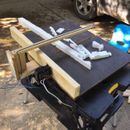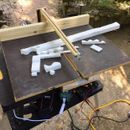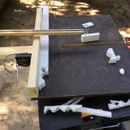Hot wire foam insulation cutter design
I have a need to cut a decent number of EPS insulation panels for a rim joist insulating project. GBA has had a number of posts in the past with hot wire cutters people have made for cutting details, but I haven’t seen any large hot wire cutters intended to quickly break down sheets of rigid foam. I also haven’t usually seen full details in one spot to go from nothing to a working hot wire cutter.
I built a larger hot wire cutter modeled on a radial arm saw with a fence that is adjustable and can cut from about 5” to about 23-1/2”. Would anyone be interested in writeup and info to allow others to duplicate this? It’s pretty simple, built primarily with 2×4 and some scrap plywood. The only “fancy” parts are a variac (to adjust voltage and therefore temperature of the hot wire), and a transformer to supply the low voltage to the hot wire.
Bill
GBA Detail Library
A collection of one thousand construction details organized by climate and house part












Replies
I love it.
But I guess you can't adjust the width without cutting a new price of 2x4?
It adjusts easily! There is a piece of 2x4 under the arm that slides in a pocket under the table. The first and last pics show it in two different positions. You just slide it to the cut width you want (like a rip fence on a table saw, sort of) and go. Originally I’d thought I’d need a clamp of some kind to keep it set in position, but it seems to be tight enough from friction to be ok.
Bill
I would be interested. I have a Manix HCM-2S that bogs down on 3-inch material, I've been thinking of how to modify it (or abandon it for another solution). I have it set into a plywood table and find that material binds on the plywood 'table' so I'm interested in what material you've used to reduce friction while sliding foam into the knife.
I haven't had that issue, but I haven’t used this much yet. I would think a few coats of polyurethane on the plywood would give a slick enough surface if you’ve had issues with a similar design.
Bill
> material you've used to reduce friction
I've had good results with UHMW polyethylene tape (in similar situations).
That’s a good idea. I use that stuff to make glides for drawers too, just about anything that binds.
I have some full sheets of unfaced type I EPS to break down today (assuming the weather holds), and that’s probably the grippiest type of rigid foam out there. I’ll see how the unfinished wood services do.
Bill
Interested in writeup and info? Sure! I notice that it comes with a comfy blue chair.
My 3 year old was “helping” me. Her new thing is to bring her little chairs around so that she can reach stuff. She says when she grows up she wants to be tall :-)
I’ll work on a writeup and post it here. I can provide some sources for some of the unusual parts too.
Bill
Did you use an actual variac? Those can get a little pricey. What about a step-down transformer to bring the peak voltage down (make it safe) and an SCR, aka cheap dimmer, to fine tune the voltage?
Yes, I used a “real” variac. If you look at the second pic where you can see all the cords, the blue device is a 10 amp variac. I have several.
In my cutter, the wire is 24 gauge nichrome, about 3-1/2” in length. It use using about 2 volts (measured across the wire), and about 5 amps. This means about 10 watts. I don’t expect a typical dimmer (which will use a triac, BTW, which is like an AC version of an SCR) to have much trouble with such a small load, but the dimmer might have an issue with the inductive load of the transformer. Inductors cause a lagging current waveform which can be a problem for some thryristor based phase controlled dimmers.
If you can find a dimmer rated for use with low voltage lights or something else with transformers (possible also dimmers rated for use with fluorescent lights) you’d probably be ok. You would need to use the dimmer on the 120v side, they won’t work correctly if at all on the low voltage side. The hot wire itself has very little voltage across it.
Note that small one and two amp variacs are pretty cheap surplus, but usually don’t have enclosures so you need to mount them in something and sometimes also add a knob. I can provide links to some sources if you’re interested.
Bill
Maybe I missed it but I see very little advantage any wood saw will cut faster and better. The only downside is some messy dust. Or a long razor blade will cut cleanly without the mess
I have a safety issue with your cutter. The first the shock hazard unless you have an isolation transformer the wire is shock hazard. Most variac’s will not isolate you from the ground.
How safe is it to breathe the fumes from burning foam? Not at all from what I understand and that is what your wire is doing.
If you decide to continue I think you should connect the wire to the output of a 12 volt battery charger and use a light dimmer on the AC input to control the heat. Are you using nichrome wire for the cutter?
You may find this link interesting.
http://www.woodturnersresource.com/extras/projects/priddle/WoodBurner.html
Walta
It’s true that I didn’t provide any guarding of the 120v side of the transformer, but I plan to add that. The transformer DOES provide isolation for the hotwire itself though, which runs only about 2 volts and floats (isolated from ground). With the transformer mounted as it is, it’s out of the way and reasonably safe even without a guard.
If the temperature is set correctly, the hot wire melts the foam but doesn’t really burn it. There is a little smell, but not much. Cutting rigid foam, especially type I EPS, with any kind of saw makes a HUGE mess of clingy static-charged particles that get everywhere. Saws also tend to rip out the type I EPS. I would actually saw a saw is not practical for type I EPS although it can work on XPS and probably also type II EPS although I haven’t tried that myself.
Bill